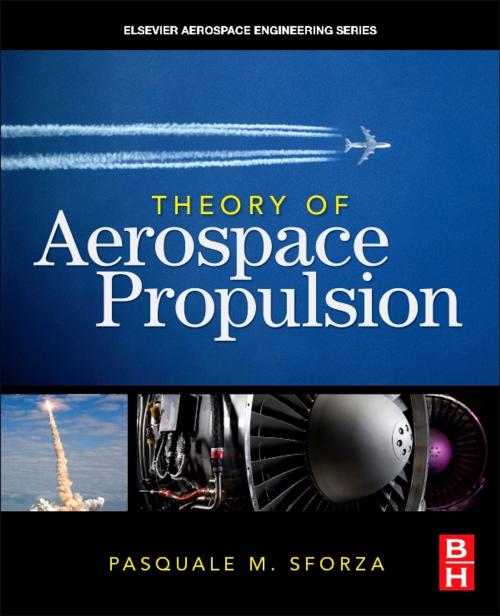Theory of Aerospace Propulsion
Nonfiction, Science & Nature, Technology, Engineering, Mechanical, Aeronautics & Astronautics| Author: | Pasquale M Sforza | ISBN: | 9780123848895 |
| Publisher: | Elsevier Science | Publication: | September 27, 2011 |
| Imprint: | Butterworth-Heinemann | Language: | English |
| Author: | Pasquale M Sforza |
| ISBN: | 9780123848895 |
| Publisher: | Elsevier Science |
| Publication: | September 27, 2011 |
| Imprint: | Butterworth-Heinemann |
| Language: | English |
Theory of Aerospace Propulsion provides excellent coverage of aerospace propulsion systems, including propellers, nuclear rockets, and space propulsion. The book's in-depth, quantitative treatment of the components of jet propulsion engines provides the tools for evaluation and component matching for optimal system performance. Worked examples and end of chapter exercises provide practice for analysis, preliminary design, and systems integration.
Readers of this book will be able to utilize the fundamental principles of fluid mechanics and thermodynamics to analyze aircraft engines; understand the common gas turbine aircraft propulsion systems and be able to determine the applicability of each; perform system studies of aircraft engine systems for specified flight conditions; perform preliminary aerothermal design of turbomachinery components; conceive, analyze, and optimize competing preliminary designs for conventional and unconventional missions. The book is organized into 15 chapters covering a wide array of topics such as idealized flow machines; quasi-one-dimensional flow equations; idealized cycle analysis of jet engines; combustion chambers for airbreathing engines; nozzles and inlets; turbomachinery; blade element analysis of axial flow turbomachines; turbine engine performance and component integration; propellers; liquid rockets; solid propellant rockets; nuclear rockets; space propulsion; and propulsion aspects of high-speed flight.
This book will appeal to aerospace or mechanical engineers working in gas turbines, turbomachinery, aircraft propulsion and rocket propulsion, and to undergraduate and graduate level students in aerospace or mechanical engineering studying aerospace propulsion or turbomachinery.
- Early coverage of cycle analysis provides a systems perspective, and offers context for the chapters on turbomachinery and components
- Broader coverage than found in most other books - including coverage of propellers, nuclear rockets, and space propulsion - allows analysis and design of more types of propulsion systems
- In depth, quantitative treatments of the components of jet propulsion engines provides the tools for evaluation and component matching for optimal system performance
- Worked examples and end of chapter exercises provide practice for analysis, preliminary design, and systems integration
Theory of Aerospace Propulsion provides excellent coverage of aerospace propulsion systems, including propellers, nuclear rockets, and space propulsion. The book's in-depth, quantitative treatment of the components of jet propulsion engines provides the tools for evaluation and component matching for optimal system performance. Worked examples and end of chapter exercises provide practice for analysis, preliminary design, and systems integration.
Readers of this book will be able to utilize the fundamental principles of fluid mechanics and thermodynamics to analyze aircraft engines; understand the common gas turbine aircraft propulsion systems and be able to determine the applicability of each; perform system studies of aircraft engine systems for specified flight conditions; perform preliminary aerothermal design of turbomachinery components; conceive, analyze, and optimize competing preliminary designs for conventional and unconventional missions. The book is organized into 15 chapters covering a wide array of topics such as idealized flow machines; quasi-one-dimensional flow equations; idealized cycle analysis of jet engines; combustion chambers for airbreathing engines; nozzles and inlets; turbomachinery; blade element analysis of axial flow turbomachines; turbine engine performance and component integration; propellers; liquid rockets; solid propellant rockets; nuclear rockets; space propulsion; and propulsion aspects of high-speed flight.
This book will appeal to aerospace or mechanical engineers working in gas turbines, turbomachinery, aircraft propulsion and rocket propulsion, and to undergraduate and graduate level students in aerospace or mechanical engineering studying aerospace propulsion or turbomachinery.
- Early coverage of cycle analysis provides a systems perspective, and offers context for the chapters on turbomachinery and components
- Broader coverage than found in most other books - including coverage of propellers, nuclear rockets, and space propulsion - allows analysis and design of more types of propulsion systems
- In depth, quantitative treatments of the components of jet propulsion engines provides the tools for evaluation and component matching for optimal system performance
- Worked examples and end of chapter exercises provide practice for analysis, preliminary design, and systems integration















